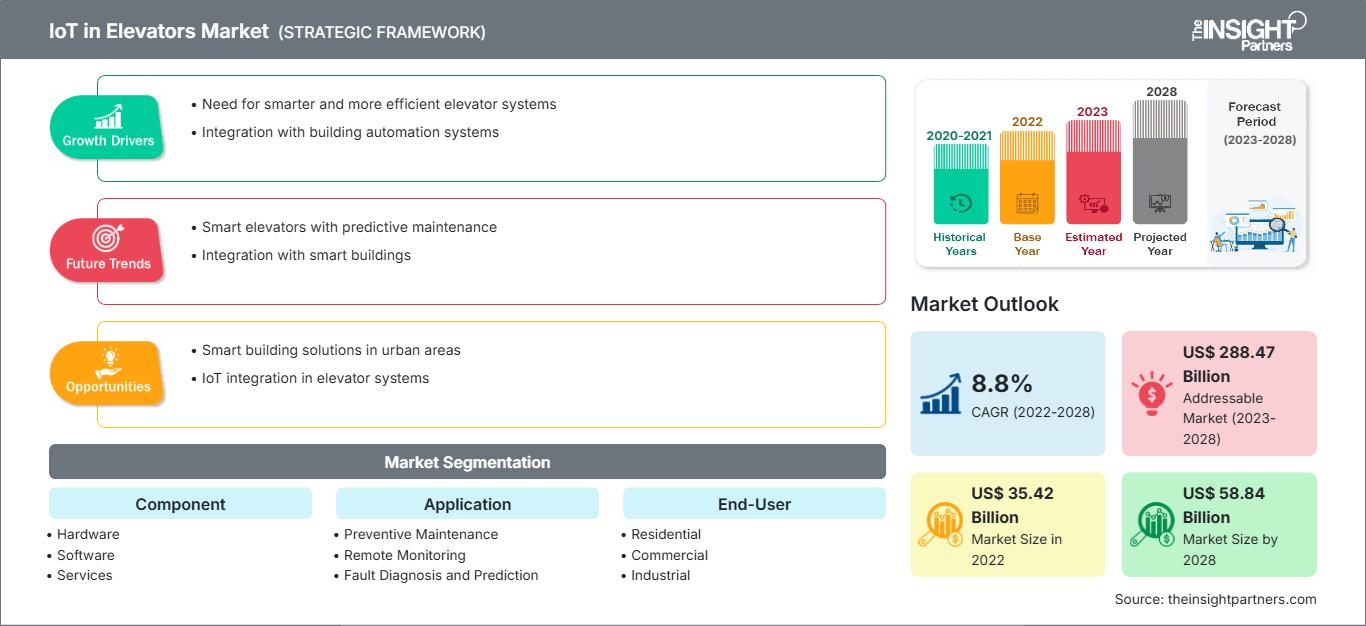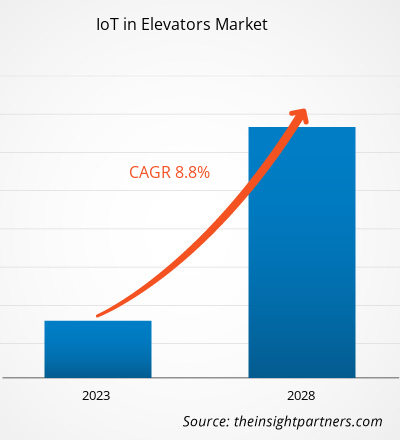[Forschungsbericht]Der Markt für IoT in Aufzügen soll von 35.415,87 Millionen US-Dollar im Jahr 2022 auf 58.843,69 Millionen US-Dollar im Jahr 2028 wachsen; von 2022 bis 2028 wird mit einer durchschnittlichen jährlichen Wachstumsrate (CAGR) von 8,8 % gerechnet.
Kleine und mittlere Unternehmen (KMU) sowie Großunternehmen sind stark auf intelligente Lösungen angewiesen. Die Einführung des IoT in diesen Unternehmen wird immer beliebter, was das Marktwachstum für IoT in Aufzügen vorantreibt. Darüber hinaus investieren viele Unternehmen angesichts des zunehmenden Wettbewerbs erheblich in intelligente Lösungen und Dienstleistungen. Dies bietet den wichtigsten Anbietern von IoT in Aufzügen lukrative Möglichkeiten, da diese Unternehmen zunehmend auf den Schutz ihres Eigentums vor internen und externen Bedrohungen angewiesen sind. Viele Regierungen investieren zudem in Stadtentwicklungsprojekte. Laut dem Ministerium für Wohnungsbau und Stadtentwicklung hat die indische Regierung seit 2014 160 Milliarden US-Dollar in die Entwicklung und Modernisierung der städtischen Infrastruktur investiert. Im Vergleich zu 2004–2014 stiegen Indiens Investitionen in den städtischen Sektor von 2014 bis 2021 um über 600 %. Die indische Regierung hat eine Nationale Infrastrukturpipeline (NIP) im Wert von 1,5 Billionen US-Dollar für Infrastrukturprojekte eingerichtet, die voraussichtlich zwischen 2020 und 2025 abgeschlossen sein werden.
Günstige politische Maßnahmen, Initiativen und massive Investitionen staatlicher und privater Organisationen in Smart Cities und Stadtentwicklungsprojekte haben lukrative Möglichkeiten für die wichtigsten Akteure im IoT-Markt für Aufzüge geschaffen. Darüber hinaus wird im Prognosezeitraum erwartet, dass wachsende Volkswirtschaften und das zunehmende Interesse an der Entwicklung führender Industriezweige die Nachfrage nach IoT-Lösungen für Aufzüge ankurbeln. Die hohen Anfangsinvestitionen in die Modernisierung von Aufzügen und die IoT-Integration bremsen jedoch das Wachstum des IoT-Marktes für Aufzüge.
Passen Sie diesen Bericht Ihren Anforderungen an
Sie erhalten kostenlos Anpassungen an jedem Bericht, einschließlich Teilen dieses Berichts oder einer Analyse auf Länderebene, eines Excel-Datenpakets sowie tolle Angebote und Rabatte für Start-ups und Universitäten.
IoT im Aufzugsmarkt: Strategische Einblicke

-
Holen Sie sich die wichtigsten Markttrends aus diesem Bericht.Dieses KOSTENLOSE Beispiel umfasst Datenanalysen, die von Markttrends bis hin zu Schätzungen und Prognosen reichen.
Auswirkungen der COVID-19-Pandemie auf das Wachstum des europäischen Marktes für IoT in Aufzügen
Die COVID-19-Pandemie hat die europäischen Länder, darunter Deutschland, Frankreich, Spanien und Italien, schwer getroffen. Italien war in der Zeit nach der Pandemie das am stärksten betroffene Land. Vor der Pandemie wurde aufgrund der wachsenden Nachfrage nach energieeffizienten Produkten und Dienstleistungen, der zunehmenden Nutzung von IoT-basierten Plattformen, Cloud-basierten Lösungen und KI sowie der wachsenden Nachfrage nach Industrialisierung in allen Industriezweigen ein deutliches Wachstum des Marktes für IoT in Aufzügen erwartet.
Die Elektronikindustrie gehört in einigen europäischen Ländern zu den am stärksten betroffenen Branchen. In der zweiten Welle des COVID-19-Ausbruchs wurde der Elektronik- und Halbleitersektor jedoch negativ von der Pandemie beeinflusst. Im Jahr 2021, mit der Lockerung der Lockdown-Maßnahmen, begann das Fertigungsgeschäft wieder. Daher haben die Aussichten für den Markt für IoT in Aufzügen an Dynamik gewonnen. Darüber hinaus wird im Jahr 2022 aufgrund des sprunghaft ansteigenden Baus von Gewerbe- und Industriegebäuden mit einem Anstieg der Nachfrage nach IoT gerechnet. Daher hat das Geschäft mit IoT in Aufzügen von der Pandemie profitiert. Im Post-Pandemie-Szenario werden die Einführung von IoT für Nachhaltigkeit, die Umstellung auf Cloud-Plattformen, zunehmende Steuererleichterungen für Bürger und verschiedene Industriezweige sowie sicherer Fernzugriff die Expansion des IoT-Marktes in Aufzügen stärken.
Markteinblicke – Markt für IoT in Aufzügen
Der globale Markt für IoT in Aufzügen ist regional in Nordamerika, Europa, Asien-Pazifik (APAC), Naher Osten und Afrika (MEA) sowie Südamerika (SAM) unterteilt.
Europa hatte 2021 den größten Marktanteil im Bereich IoT in Aufzügen und wird den Markt voraussichtlich auch im Prognosezeitraum dominieren. Die Einführung von 5G und Investitionen von Unternehmen in die Verbesserung der 5G-Infrastruktur treiben das Marktwachstum in der Region voran. Deutschland hat im Laufe der Jahre eine lange Geschichte von Investitionen und Innovationen im Bereich des industriellen IoT. Das Land ist außerdem führend bei der Nutzung von 5G zur Ausweitung des industriellen IoT. Die wachsende Nachfrage nach industriellen Bildgebungssystemen im gesamten industriellen Fertigungssektor sowie nach fortschrittlichen Infotainmentteilen, Fahrerüberwachungsgeräten und Fahrersteuergeräten für die Automobilindustrie beeinflusst die Nachfrage nach IoT in Aufzügen im Fertigungs- und Automobilsektor zusätzlich. Die schnell wachsende Bautätigkeit im gewerblichen Sektor im ganzen Land erhöht auch die Nachfrage nach IoT-basierten Aufzugssystemen. Diese Faktoren fördern das Wachstum des IoT-Marktes in Aufzügen in Europa.
Nordamerika hatte 2020 den zweitgrößten Anteil am IoT-Markt in Aufzügen. Der Markt in den USA wird im Prognosezeitraum voraussichtlich seine robusten Wachstumsaussichten beibehalten. In den USA treiben das steigende verfügbare Einkommen und der verbesserte Lebensstandard die Nachfrage nach intelligenter Elektronik an. Die Nachfrage nach Miniaturgeräten ist aufgrund der wachsenden Popularität von KI und der industriellen Revolution 4.0 hoch. Darüber hinaus investieren viele Hersteller massiv in die Entwicklung von Systemen zur Digitalisierung intelligenter Elektronik, beispielsweise für Automatisierungsanwendungen der Infrastruktur. Die US-Regierung hat zahlreiche Initiativen zur Förderung der Elektronikindustrie ergriffen. Am 6. Mai 2022 legte die Regierung einen neuen parteiübergreifenden Gesetzesentwurf vor, um die Leiterplattenbranche des Landes anzukurbeln. Viele etablierte Unternehmen der Elektronikfertigung begrüßten den Vorschlag. Der Gesetzentwurf unterstützt den CHIPS Act von 2021 und den American Printed Circuit Boards Act von 2022. Dadurch ergeben sich für Schlüsselakteure im IoT-Markt für Aufzüge viele lukrative Möglichkeiten.
Komponentenbasierte Erkenntnisse
Basierend auf den Komponenten ist der IoT-Markt für Aufzüge in Hardware, Software und Dienstleistungen unterteilt. Das Hardwaresegment machte 2021 den größten Markt aus. Die Nachfrage nach Hardware ist in den letzten Jahren dramatisch gestiegen. Künstliche Intelligenz wird eingesetzt, um Betreiber und Monteure bei der Einhaltung ihrer täglichen Routinen zu unterstützen und Wege zu finden, den Aufzugsverkehr zu steuern und Problemen vorzubeugen, basierend auf Daten, die aus der täglichen Aufzugsnutzung gesammelt werden.
Basierend auf den Anwendungen ist der Markt für IoT in Aufzügen in vorbeugende Wartung, Fernüberwachung, Fehlerdiagnose und -vorhersage, erweitertes Reporting und Konnektivitätsmanagement unterteilt. Der Markt für IoT in Aufzügen ist nach Endnutzern in Wohn-, Gewerbe- und Industriebereiche unterteilt. Geografisch ist der Markt hauptsächlich in Nordamerika, Europa, den Asien-Pazifik-Raum (APAC), den Nahen Osten und Afrika (MEA) sowie Südamerika unterteilt.
OTIS; Schindler Group; KONE Corporation; Hyundai Elevator Co., Ltd.; und Fujitec gehören zu den führenden Akteuren im Markt für IoT in Aufzügen. Der Markt ist stark fragmentiert, wobei sich mehrere Akteure in einer bestimmten Region befinden, um die Inlandsnachfrage zu bedienen.
IoT in Aufzügen
Regionale Einblicke in den IoT-Markt im AufzugsbereichDie Analysten von The Insight Partners haben die regionalen Trends und Faktoren, die den Markt für IoT-Aufzüge im Prognosezeitraum beeinflussen, ausführlich erläutert. In diesem Abschnitt werden auch die Marktsegmente und die geografische Lage des IoT-Marktes in Nordamerika, Europa, im asiatisch-pazifischen Raum, im Nahen Osten und Afrika sowie in Süd- und Mittelamerika erörtert.
Umfang des Marktberichts zum IoT in Aufzügen
| Berichtsattribut | Einzelheiten |
|---|---|
| Marktgröße in 2022 | US$ 35.42 Billion |
| Marktgröße nach 2028 | US$ 58.84 Billion |
| Globale CAGR (2022 - 2028) | 8.8% |
| Historische Daten | 2020-2021 |
| Prognosezeitraum | 2023-2028 |
| Abgedeckte Segmente |
By Komponente
|
| Abgedeckte Regionen und Länder |
Nordamerika
|
| Marktführer und wichtige Unternehmensprofile |
|
Dichte der Marktteilnehmer im Bereich IoT im Aufzugssektor: Die Auswirkungen auf die Geschäftsdynamik verstehen
Der Markt für IoT in Aufzügen wächst rasant. Die steigende Nachfrage der Endnutzer ist auf Faktoren wie veränderte Verbraucherpräferenzen, technologische Fortschritte und ein stärkeres Bewusstsein für die Produktvorteile zurückzuführen. Mit der steigenden Nachfrage erweitern Unternehmen ihr Angebot, entwickeln Innovationen, um den Bedürfnissen der Verbraucher gerecht zu werden, und nutzen neue Trends, was das Marktwachstum weiter ankurbelt.

- Holen Sie sich die IoT im Aufzugsmarkt Übersicht der wichtigsten Akteure
Akteure der Marktanalyse zum IoT in Aufzügen konzentrieren sich hauptsächlich auf die Entwicklung fortschrittlicher und effizienter Produkte.
- Im Dezember 2021 ging KONE, ein multinationaler Aufzugs- und Rolltreppenhersteller, eine Partnerschaft mit Amazon Web Services (AWS) ein, der weltweit umfassendsten und am weitesten verbreiteten Cloud-Plattform. AWS wird KONE weltweite Cloud-Funktionen bereitstellen, darunter Internet der Dinge (IoT) und Analysefunktionen. Darüber hinaus werden die Unternehmen zusammenarbeiten, um neue Technologien zu entwickeln, die die Skalierbarkeit und Leistung der vernetzten Dienste und Lösungen von KONE verbessern.
- Im April 2021 gab Mitsubishi Electric Corporation bekannt, dass ihre Tochtergesellschaft Mitsubishi Elevator India Private Limited (IMEC) einen unterzeichneten Vertrag zur Lieferung von Aufzügen für die Luxuskomplexe Commerzone Madhapur und Altimus von K RAHEJA CORP, einem renommierten Bauträger in Indien, erhalten hat.
- Historische Analyse (2 Jahre), Basisjahr, Prognose (7 Jahre) mit CAGR
- PEST- und SWOT-Analyse
- Marktgröße Wert/Volumen – Global, Regional, Land
- Branchen- und Wettbewerbslandschaft
- Excel-Datensatz
Aktuelle Berichte
Erfahrungsberichte
Grund zum Kauf
- Fundierte Entscheidungsfindung
- Marktdynamik verstehen
- Wettbewerbsanalyse
- Kundeneinblicke
- Marktprognosen
- Risikominimierung
- Strategische Planung
- Investitionsbegründung
- Identifizierung neuer Märkte
- Verbesserung von Marketingstrategien
- Steigerung der Betriebseffizienz
- Anpassung an regulatorische Trends






















 Kostenlose Probe anfordern für - IoT im Aufzugsmarkt
Kostenlose Probe anfordern für - IoT im Aufzugsmarkt